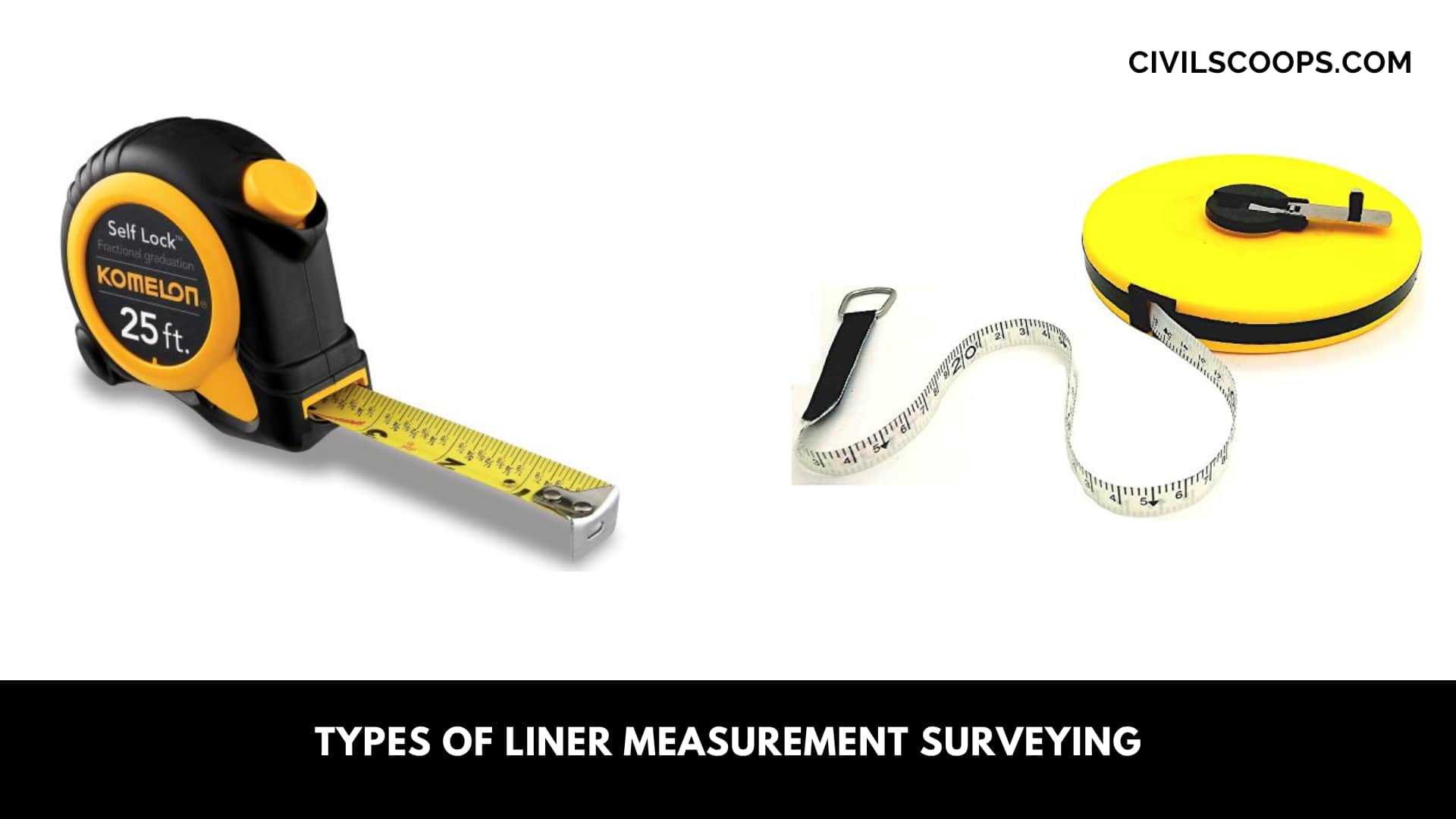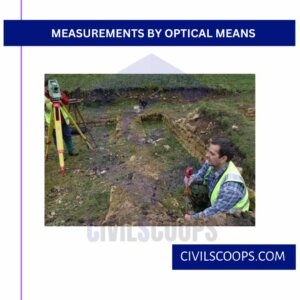What Is Linear Measurement Surveying | Types of Linear Measurement Surveying

Table of Contents
Introduction of Measuring Distance
- Distance measurement is usually regarded as the most fundamental of surveying observations. In traditional ground surveys, although many angles might be read, the length of at least one line has to be measured to supplement the angles in locating points.
- In-plane surveying, the distance between two points means the horizontal distance. When the points are at different elevations, the distance is the horizontal length between vertical lines in the points.
- Lengths of lines could be specified in different units. In the USA, the foot, decimally divided, is usually used through the meter is becoming more and more common. Geodetic surveys and lots of highway surveys use the meter.
- In machine and architectural function, and on some construction projects, the unit is a foot divided into inches and fractions of an inch.
- In surveying, the most commonly employed units are such as length, area, volume, and angle.
- Two different systems are in use for specifying units of observed quantities, both the English and metric systems.
- Due to its widespread adoption, the metric system is called the International System of Units and abbreviated SI.
Also Read: What Is Passometer & Pedometer | Advantage of Passometer & Pedometer | Passometer Vs Pedometer
What Is Linear Measurement Surveying?

Surveyors are concerned with the measurement of vertical and horizontal distances and angles and, even more recently, with direct positioning.
These, then, are used in a variety of combinations in traversing, triangulation, trilateration, mixed-mode operations, mapping, layout staking, leveling, etc.
Types of Liner Measurement Surveying.

- Direct Measurements.
- Measurements by Optical Means
- Electra-Magnetic Methods.
In the case direct measurements, distances are measured on the ground with the help of a chain or tape or any other instrument.
In the optical methods, observations are taken through a telescope, and calculations are done for the distances, such as in tachometer or triangulation.
In the electro-magnetic methods, distances are measured with instruments that rely on propagation, reflection, and subsequent reception of either radio waves. Light waves or infrared waves.
Also Read: Benchmark in Surveying | TBM in Surveying | GTS Benchmark| Permanent Benchmark | Arbitrary Benchmark
1. Direct Measurements.

Measuring the distance directly as below
- Pacing
- Measurement with Passometer
- Measurement with Pedometer
- Measurement by Odometer and Speedometer
- Changing
1.1. Pacing
Measurements of distances by pacing are chiefly confined to the preliminary surveys and explorations where a surveyor is called upon to do a rough survey as quickly as possible.
It may also be used to roughly check the distances measured by other means. The method consists of counting the number of paces between the two points of a line.
The length of the line can then be computed by knowing the average length of the pace. The length of pace varies with the individual, & also with the nature of the ground, the slope of the country, and the speed of pacing.
A length of pace, more nearly that of one’s natural step, is preferable. The length of one’s natural step may be determined by walking on the fairly level ground over various lines of known lengths.
One can soon learn to pace distances along with level, unobstructed ground with a degree of accuracy equivalent approximately to 1 in 100. However, pacing over rough ground or on slopes may be difficult.
1.2. Measurement with Passometer
Passometer is an instrument shaped like a watch that is carried either in the pocket or is attached to one leg.
When the person wearing the Passometer walks, it counts the number of paces the person has moved.
Then by multiplying the number of paces with the average pace length, the distance between the two end stations can be determined.
1.3. Measurement with Pedometer
A pedometer is a device similar to the passometer except that, adjusted to the length of the pace of the person carrying it. It registers the total distance covered by any number of paces.
1.4. Measurement by Odometer and Speedometer
The odometer is an instrument for registering the number of revolutions of a wheel. The well-known speedometer works on this principle.
The odometer is fitted to a wheel that is rolled along the line whose length is required. The number of revolutions registered by the odometer can then be multiplied by the circumference of the wheel to get the distance.
Since the instrument registers the length of the surface actually passed over, its readings obtained on the undulating ground are inaccurate.
If the route is smooth, the speedometer of an automobile can be used to measure the distance approximately.
1.5. Changing
Chaining is a term that is used to denote measuring distance either with the help of a chain or a tape and is the most accurate method of making direct measurements.
For work of ordinary precision, a chain can be used, but for higher precision, a tape or special bar can be used. The distances determined by chaining form the basis of all surveying.
No matter how accurately angles may be measured, the survey can be no more precise than the chaining.
2. Measurements by Optical Means

In this method, observations are taken through a telescope, and calculations are done for distances such as in tachometer (stadia) or in triangulation.
Tachometer (stadia is the common term in the USA ) is a surveying method utilized to quickly determine the horizontal distance to, and elevation of, a point.
Stadia observations are accessed by sighting through a telescope equipped with two or more horizontal cross wires in a spacing that is known
The apparent intercepted length between the bottom and top wires is read onto a graduated rod held vertically in the desired stage.
The space from the telescope to a rod is seen by proportional relationships in similar triangles. Accuracy of 1/500 of this distance is achieved with reasonable care
3. Instruments Used in the Tachometer

3.1. Tacheometer
It’s Only a transit theodolite fitted Using a stadia diaphragm along with an analytic lens. As per below fig, No-1 shows the different forms of stadia diaphragm commonly used:
3.2. Levelling Staff and Stadia Rod
For short distances, ordinary leveling staves are used. The leveling staff is normally 4 m long and can be folded into three parts.
The graduations are so marked a minimum reading of 0.005 or 0.001 m, could be taken. For long sights, as specially designed graduated rod is utilized, which is called a stadia rod.
It’s also 4 m long, and could possibly be telescopic or brushed. The graduations are comparatively clear and daring, and the minimum reading Which Can Be taken is 0.001 m.
3.3. Electra-Magnetic Methods
In the case of electronic methods, the distances are measured with instruments that are based on propagation, reflection, and subsequent reception of either radio or light waves.
The instruments used under the electronic methods are Geodimeter, Tellurometer, and Decca Navigator, etc.
The main instrument for surveyors on site today is the ‘total station.’ It is an instrument that combines the angle measurements that could be obtained with a traditional theodolite with electronic distance measurements.
Taping distance, with its associated problems, has been rendered obsolete for all base-line measurement.
The distance can now be measured easily, quickly, and with great accuracy, regardless of terrain conditions.
Modern total stations as in as per below fig no-2 and as in as per below fig no-3 contain algorithms for reducing the slope distance to its horizontal and vertical components.
For engineering surveys, total stations with automatic data logging are now standard equipment on site.
A typical measurement of distance takes between 1.5 and 3 s. Automatic repeated measurements may be utilized to improve reliability in tough atmospheric conditions.
Tracking modes, for the setting from distance, repeat the measurement several times a second. Total stations with their inbuilt EDM enable:
- Traversing over great distances, with much greater control of swing errors.
- The inclusion of the many more measured distances into control networks, rendering classical triangulation outdated. This results in a much greater control scale error.
- Setting-out and photogrammetric control, over the large areas, by polar coordinates from a single baseline.
- Deformation monitoring into sub-millimeter accuracies using high-precision EDM, such as the Mekometer ME5000.
- This instrument has a range of 8 km, and an accuracy of ±0.2 mm ±0.2 mm/km of the distance measured ignoring unmodelled refraction effects.
[su_box title=”FAQ” style=”default” box_color=”#333333″ title_color=”#FFFFFF” radius=”3″ class=”” id=””]
What Is Linear Measurement in Surveying?
In an engineering survey, the linear horizontal distance has to be measured. The measurement of this linear horizontal distance between two points on the earth’s surface is known as linear measurement.
Types of Linear Measurement in Surveying
Linear measurements in surveying can be performed by mainly three methods namely direct method, electromagnetic methods and optical methods. The direct method is the common method that employs a chain, tape or any other instrument to measure the linear distance.
In Which Type of Surveying Only Linear Measurements Are Made?
Chain survey is the simplest and traditional method of surveying. In chain survey, only linear measurements are taken in the field, and the rest work, are done officially.
How to Find Linear Measurement?
To measure linear footage, all you need is a tape measure. Just measure the length in inches and then divide the total number of inches by 12 to convert to feet. The resulting number is the linear footage. For this measurement, width and height don’t matter!
[/su_box]
[su_note note_color=”#F2F2F2 ” text_color=”#333333″ radius=”3″ class=”” id=””]
Like this post? Share it with your friends!
Suggested Read –
- What Is DLC (Dry Lean Concrete) | Advantage of DLC (Dry Lean Concrete)
- Carbon Steel vs. Stainless Steel | What Is Carbon Steel | What Is Stainless Steel
- Benchmark in Surveying | TBM in Surveying | GTS Benchmark| Permanent Benchmark | Arbitrary Benchmark
- All About Soffit | What Is Soffit | Different Types of Soffit | What Is Fascia | Advantages & Disadvantages of Fascia and Soffits |
- All About FSI and FAR | What Is FSI | What Is FAR | What Is Premium FSI | FSI Full Form | FAR Full Form
[/su_note]
Originally posted 2023-03-27 11:17:17.
